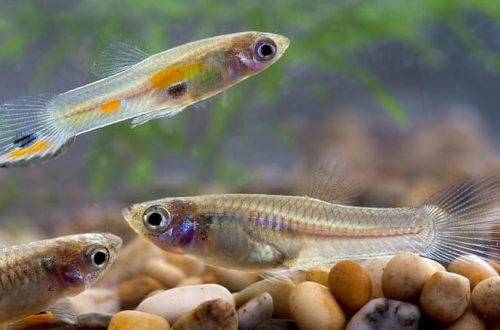
Somik wasp
Akisis Vespa, Orange stone catfish or Catfish wasp, scientific name Akysis vespa, belongs to the family Akysidae (Akizovye). Beautiful colors, peaceful disposition and ease of maintenance make this catfish a good choice for both beginners and experienced aquarists.

Contents
Habitat
Comes from Southeast Asia. It is considered endemic to the upper basin of the Salween River in the area of the northern border between Thailand and Myanmar. The typical habitat is fast-flowing streams and rivers with sandy-stony substrates. The water is clean and clear, a small suspension appears during the rainy season. Aquatic vegetation is usually not found, but the bottom of the rivers is littered with fallen leaves and snags.
Brief information:
- The volume of the aquarium – from 40 liters.
- Temperature – 16-24°C
- Value pH — 6.0–7.2
- Water hardness – 2–12 dGH
- Substrate type – sand, gravel
- Lighting – any
- Brackish water – no
- Water movement – moderate or strong
- The size of the fish is 4–5 cm.
- Food – live or frozen food
- Temperament – peaceful
- Content alone or in a group
Description
Adults reach a length of about 3 cm. The color is orange-yellow with alternating dark markings. Thanks to this coloring, the catfish got its own – “Wasp”, the Latin word vespa, which is present in part of the scientific name, is also translated. The fish has a large head with several long antennae and a rather narrow body. Fins and tail are short. Sexual dimorphism is weakly expressed. External differences between male and female are insignificant.
Food
Feeds at night. The basis of the diet is small zooplankton. In a home aquarium, live or frozen foods, such as brine shrimp, daphnia, bloodworms, should also be fed. Over time, if this has not happened yet, they can be accustomed to dry food in the form of flakes, granules. Serve shortly before turning off the lights in the aquarium.
Maintenance and care, arrangement of the aquarium
The optimal size of the aquarium for a group of 5-6 fish starts from 40 liters. The design is simple, the main elements of the decor are large boulders and snags placed in a layer of sandy soil. It is noted that Somik-osa, being a nocturnal inhabitant, during the daytime prefers to hide in crevices between stones, so it is necessary to provide such places. Otherwise, he may choose an inappropriate place, squeezing himself between the internal equipment and the tank wall.
Although aquatic plants are not characteristic of the natural habitat of this species, they are quite appropriate for some aquarium landscaping. You can use artificial vegetation, or choose from hardy varieties such as anubias, bucephalandra, as well as mosses and ferns.
Being natives of flowing reservoirs, Orange stone catfish needs clean water rich in dissolved oxygen. The presence of an internal flow is welcome. A productive filtration system can solve these problems. Do not neglect regular maintenance procedures. In particular, it is necessary to replace part of the water (30–50% of the volume) with fresh water weekly and regularly remove accumulated organic waste.
Behavior and Compatibility
A peaceful calm fish that is not able to compete with more active catfish, therefore, as neighbors in the aquarium, you should choose from among the species that live in the water column or near the surface. Good candidates for this role will be neons and other small tetras, zebrafish, rasboras.
Breeding / breeding
In nature, spawning occurs with the onset of the rainy season. The stimulus is a decrease in water temperature (by about 7°C) and a change in its hydrochemical composition towards neutral pH values. The incubation period lasts 4 days, after another 11 days the fry begin to swim freely. They grow quickly, after a month they reach adult size. Cases of breeding in the home aquarium are rare due to the need to recreate the external conditions to stimulate spawning.
Fish diseases
The cause of most diseases is unsuitable conditions of detention. A stable habitat will be the key to successful keeping. In the event of symptoms of the disease, first of all, the quality of the water should be checked and, if deviations are found, measures should be taken to correct the situation. If symptoms persist or even worsen, medical treatment will be required. Read more about symptoms and treatments in the Aquarium Fish Diseases section.





